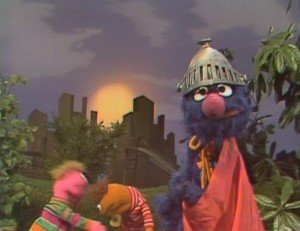Sesame St S6: Highlights
As you see, Don just cannot figure out a good rhyme for “snow” and so finds himself incapable of figuring what what the “lamb was sure to” do, “everywhere that Mary went,” something with causes him so much anguish, he apologizes to the bust of Beethoven–who seems to be mocking him with his genius–on his piano! Kermit steps in and suggests “run,” which gives Don no pleasure because it doesn’t rhyme with “snow,” to which Kermit suggests he alter the earlier line to “Mary had a little lamb/As yellow as the sun/And everywhere that Mary went, the lamb was sure to run!” Which rhymes beautifully, except for the fact that lambs aren’t yellow! Which makes some really nifty, subtle points to children, teaching about rhyming while at the same time weaving in an implied message about the importance of making sense when composing a poem, not just sticking words together because they sound good.
The chain continues thusly: Kermit suggests that Don simply change the “lamb” to a “canary,” which is yellow, but the problem there is a canary wouldn’t run but fly, so Kermit swaps “yellow as the sun” for “bluer than the sky,” which causes a whole new problem, because canaries aren’t blue and that was the whole point of choosing a canary in the first place! That’s when Kermit has a stroke of genius: a bicycle can be any color! Don decides he wants it to be red, so Kermit improvises: “Mary had a bicycle/It was painted red as fire/And whenever Mary wanted to take a ride/The bicycle had a flat tire.” And Don loves it, a moment later calling in his back-up singers–who just so happen to be the Alphabeats from “Telephone Rock”!–to record it on the spot.
These sketches are also fun becuase, unlike most Kermit reporter scenes, he actually gets to have an impact on the outcome, perhaps losing some of his journalistic integrity but making for some even more entertaining back-and-forth between him and his interview subject.
Next on the disc, I watched the Pointer Sisters doing a swinging song called “Swingin’ Alphabet,” followed by another adventure from Super Grover! Just as in the previous Super Grover sketch, the joke is that he comes to help a child facing some sort of problem but ends up providing no help whatsoever, despite his insistence that he has. The first one, however, might constitute a slightly bad message in that not only did he not actually assist the lost little girl but he even impeded her progress in getting home, physically obstructing her from placing a phone call to her mom by usurping the booth himself in order to change into his superhero outfit, and then actually proceeding to lift the phone booth, with her inside it, despite not knowing where her mother was. In other words, he actually did more harm than good and one could argue made a frightening situation for a child even worse.
This one, however, doesn’t have any of those potentially troubling elements. Instead of being a hindrance, Super Grover is basically just ignored all together. Two brothers are bitterly fighting over an apple, only pausing for a moment to look up in awe at what could possibly be flying towards them. In a nod to Superman, Super Grover’s role model, the boys excitedly say “It’s a bird! It’s a plane!” and then disappointedly realize, “It’s Super Grover…” before immediately returning to their fight. Meanwhile, Super Grover crash lands, which would become another staple of these sketches, further underlining his incompetence as a superhero. And while Super Grover then proceeds to attempt to talk them out of their argument, they don’t pay him any attention whatsoever, ultimately realizing that the best solution is to apologize to one another and simply split the apple in half. Super Grover, however, is so caught up in his reverie that he doesn’t realize they hadn’t listened to him and so naturally assumes that he has succeeded in yet another quest…before tearing his cape while trying to achieve lift-off again.
What’s so great about the Super Grover sketches is that they manage to gently mock Grover to an extent–he certainly doesn’t realize he’s the butt of the joke–while at the same time, making his can-do spirit and optimism so infectious that it never feels mean-sprited. Grover is basically an eager kid who is so open-hearted and full of love that he genuinely wants to provide service to everyone, whether they like/need it or not, and so while his efforts never work out as intended, it comes across as more sweet (if sweetly misguided) than foolish.
The next sketch is yet another of the Rube-Goldberg-device films of a red ball rolling through an obstacle course, this one ending on the ball turning into 3 cherries, each of which lands on one of 3 ice cream sundaes, 1 of which is devoured by an eager little girl, and then we have the singer/songwriter, Richie Havens (a favorite of my mom’s), singing “Wonder Child,” a song he composed for Sesame Street. It’s a gentle, pretty song about the perspective of a child bringing wonder into the lives of adults too, however it’s also so slowly paced and blandly presented (no Muppets or choreography) that I can’t imagine a child not getting extremely antsy during it, especially because it’s really targeted to adult viewers. Children wouldn’t generally be able to appreciate its message and probably wouldn’t respond to its glacial pacing.
That’s followed by another Twiddlebugs sketch! Whereas the last time we saw them, they were trying to figure out the best way to get to the zoo, this time Papa Twiddlebug has brought home a postage stamp, which is of course quite large to them…large enough to be hung on their wall as a painting. And yet what is the best way to accomplish that task?
Like the previous Twiddlebug sketch, it centers on the idea of the Twiddlebugs being generally silly creatures, and the children possibly being smarter than the adults. At first they have trouble deciding which side to display, the picture of George Washington on the front or the glue on the back, but when their efforts to hang it glue-side-out fail, the boy suggests that perhaps the picture is the part they should be seeing (“My son, the genius!” the father exclaims). And when the glue side won’t stick to the wall either, the daughter remembers that you need to lick the glue for it to get sticky (“My daughter, the super brain!”), at which point the entire family licks the back of the stamp and then hang it on the wall…upside down! As with how they pulled their car to the zoo at the end of the last sketch, they never get it quite right in this one either. “Maybe George Washington liked to stand on his head,” Papa suggests, while Mama sighs, “‘Tis a puzzlement,” unconsciously quoting the King from The King and I, in his famous solo number.

